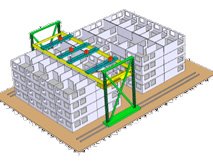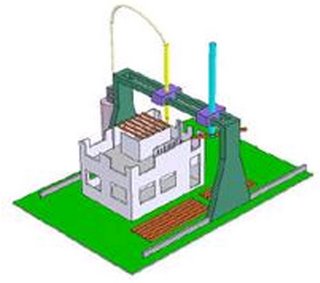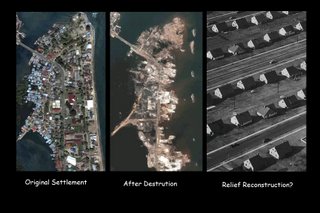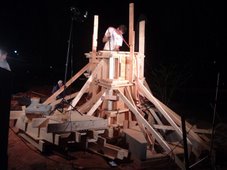 hich he claims will do just that. Khoshnevis is in the process of developing a printer of sorts which can print buildings. He hopes that such machines in the future will be able to build houses, offices, schools and even hospitals. Khoshnevis claims that the first printers will be available for commercial purchase around 2008. These machines use a specially developed concrete mixture to lay down layers of concrete a few inches thick. The Contour Crafter will also be able to install electrical lines and plumbing; the crafter will even be able to do work as specific as printing wallpaper into place. The only thing left to do by manual labor will be installing windows, doors, and other fixtures. Khoshnevis speculates that in twenty years from now the contour crafter will replace most manual labor in the construction industry. The contour crafter is expected to reduce construction costs of a house by about 75% and the construction time to just one day. More detailed information including videos, media reports and a link to the Contour Crafting blog is available at the Contour Crafting website.
hich he claims will do just that. Khoshnevis is in the process of developing a printer of sorts which can print buildings. He hopes that such machines in the future will be able to build houses, offices, schools and even hospitals. Khoshnevis claims that the first printers will be available for commercial purchase around 2008. These machines use a specially developed concrete mixture to lay down layers of concrete a few inches thick. The Contour Crafter will also be able to install electrical lines and plumbing; the crafter will even be able to do work as specific as printing wallpaper into place. The only thing left to do by manual labor will be installing windows, doors, and other fixtures. Khoshnevis speculates that in twenty years from now the contour crafter will replace most manual labor in the construction industry. The contour crafter is expected to reduce construction costs of a house by about 75% and the construction time to just one day. More detailed information including videos, media reports and a link to the Contour Crafting blog is available at the Contour Crafting website.  The hope is that the Contour Crafter will be able to solve problems of housing for people suffering from poverty, disaster relief, and just to make homes in general more affordable. Disasters victims such as those after Hurricane Katrina would receive relief housing with plumbing and electricity in a mater of days. Khoshnevis’ website uses the example of a recent earthquake in
The hope is that the Contour Crafter will be able to solve problems of housing for people suffering from poverty, disaster relief, and just to make homes in general more affordable. Disasters victims such as those after Hurricane Katrina would receive relief housing with plumbing and electricity in a mater of days. Khoshnevis’ website uses the example of a recent earthquake in
 On a different note, what would the Contour Crafter do to high end design? According to Khoshnevis, the Crafter can easily create complex walls, with curves and bends at a fraction of the cost that a conventional construction crew could. He claims that the machine can open the door to more freedom in design. It seems as though this may be true and may even be a goal of Khoshnevis’. However, the people who will most likely purchase these contour crafters will be contractors, not designers. Will architecture turn into just another mundane process? With cookie cutter padio homes so popular today will the construction of building go even farther and bypass the architect all together; customers will simply pick out a plan from a data base and press print?
On a different note, what would the Contour Crafter do to high end design? According to Khoshnevis, the Crafter can easily create complex walls, with curves and bends at a fraction of the cost that a conventional construction crew could. He claims that the machine can open the door to more freedom in design. It seems as though this may be true and may even be a goal of Khoshnevis’. However, the people who will most likely purchase these contour crafters will be contractors, not designers. Will architecture turn into just another mundane process? With cookie cutter padio homes so popular today will the construction of building go even farther and bypass the architect all together; customers will simply pick out a plan from a data base and press print?

1 comment:
contour crafting is definitely an exciting technology, and yes, i think architects would love to use them. Greg Lynn, Francois Roche (and I) are already speculating on their use. What your post doesn't cover is the notion of MEGA. ok, you can build a house quickly, a city quickly, but how does this affect the larger scale. pehaps some images that go along with numbers suggesting how large a city, where that city will be built, how many cities in a decade? a century? where are populations expanding the greatest where the demand for this would be best utilized? more MEGA.
Post a Comment